The maps of our large mines are usually prepared with the greatest care; and it is somewhat singular that, in comparison with the great amount of time and money spent in surveying and platting, so little actual use is made of them. Almost the only purpose for which a completed survey-map is afterwards consulted, is the determination of the relative position of the different workings to each other, and to the boundary-lines of the property.
After the completion of such a map, it should be made the beginning of another, and in most cases a far more important undertaking, namely, its utilization as a starting-point for a complete inventory of the company’s underground possessions. The ordinary mine-survey map, being nothing but a record of what has been done, is, in one sense, only ancient history. To increase its value, such additions should be made as will render it a complete statement of the amount and value of ore in sight at any particular time, and a guide for future development. Comparatively little extra labor is involved in this undertaking, since the larger and most expensive part of the work has already been completed when the mine has been surveyed and mapped. The necessary additions consist in working out and platting on the maps, the geology of the mine as exposed in the workings, in such a manner that the geological survey may be of daily use in the development and operation of the mine.
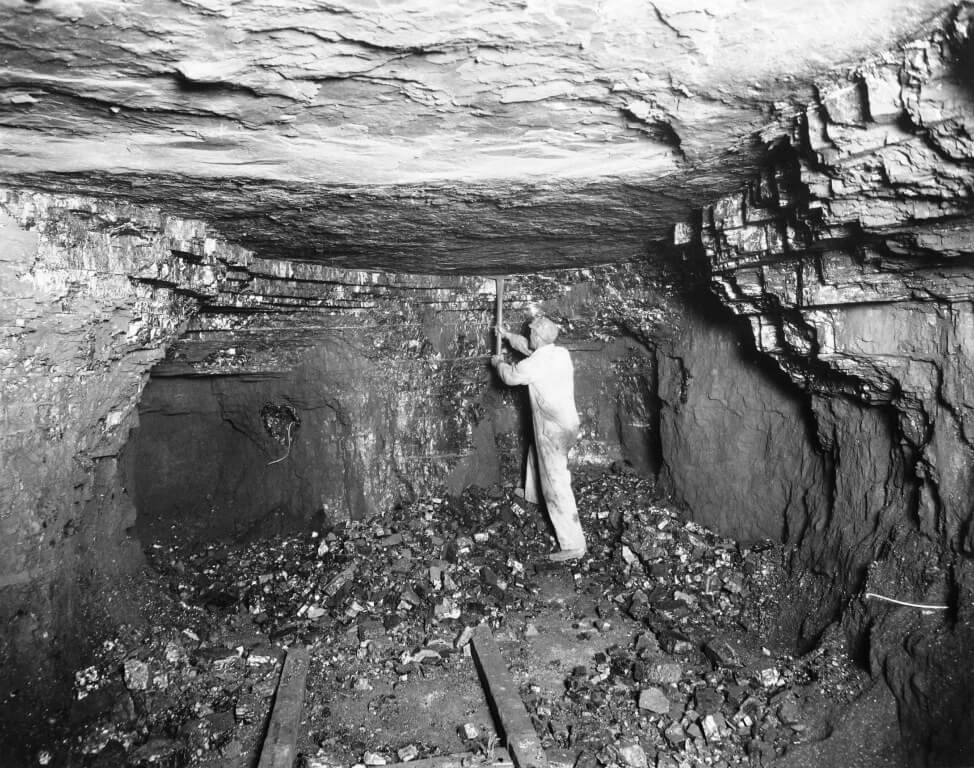
The first step towards the production of a geological map consists in tracing individual level-sheets from the general or composite map. The area to be included, outside of the property in question, will depend very much on local conditions; but, for geological, legal and commercial reasons, it should be extended as far as reasonably practicable. The scale to be ton) makes the development of a local field appear an attractive business-proposition. It must be borne in mind, however, that a considerable percentage of this cost of coal is represented by the lighterage charges at Nome. It does not seem likely that any local field can be developed which will escape the lighterage charges, which are variously estimated at $50 @ $100 per ton. The high wages, from $100 to $120 a day, which prevail in this region, is another factor which must be taken into account.
It cannot be too often urged, that any enterprise which undertakes a search for coal to supply the Nome market should establish both the quality and quantity of coal before making a large investment.
In the Yukon province, wood is the customary fuel. Up to two years ago, nearly all the score or more of river-steamers, which carried on the summer transportation business, burned wood, but a few thousand tons of coal were annually imported or mined along the Yukon river. Since the introduction of petroleum-burning engines on the steamers, all coal-mining has ceased, but some coal is still imported. It has been shown that on the Lower Yukon there are some bituminous coals of fair grade. These occur in commercial seams, and it would appear that they ought to afford a cheaper fuel than petroleum, which is brought more than 3,000 miles. Though there is considerable timber in the Yukon basin, only a small part of it is accessible to the waterways, and this is rapidly being cut. The time is not far distant when fuel will either have to be brought into the country, or roads be constructed which shall make other timber accessible. The rapid increase of placer-mining operations, specially those which make use of steam-power, will increase the demand for fuel. If the local coals, even if of a lignitic character, can be transported at reasonable cost to the mining-centers, they will undoubtedly find a large market. The introduction of gas-engines, to which the lignites are so well adapted, may yet reduce, materially, the cost of placer-mining operations. It appears that the lignitic coal on Washington creek on the upper river may eventually find a local market for mining-purposes. The coal near Rampart should supply the placer-camps of the immediate region. If the railroad be extended through the Cantwell River coal-field from the coast, it will probably supply Fairbanks with fuel from this local source.
Much higher cost to the consumer. At present, this fuel is all brought a distance of nearly 3,000 miles, either from Puget sound or from British Columbia. There are three possible local sources of coal: (1) the Alaska peninsula; (2) the region bordering Norton sound, and (3) near Cape Lisburne.
The coal-fields of Alaska peninsula are not very promising, but that of Herendeen bay may yet yield a fuel-supply, through its development thus far has been anything but a commercial success. This bay is accessible throughout the year, has a good harbor, and is about 700 miles distant from Nome. In any event, plans for developing the Norton Bay and Cape Lisburne fields should take into account the possibility of coming into competition with the Alaska Peninsula coals. The commercial value of the coals in the Norton Sound region has still to be proven, for, up to the present time, only small areas of lignitic coals have been found, but it is not impossible that somewhat higher grade coals may here occur, such as those of the Lower Yukon, and even the lignitic coals may yet have their value in the Nome market. The profit in mining these lower-grade coals must be found at a selling-price which will be determined by the relative fuel-value of the lignites and the imported bituminous coals. Though lignitic coal has been mined at a profit on Chicago creek in the Seward peninsula for two years, it must be remembered that this fuel hardly comes in competition with imported coals.
The Cape Lisburne fields, 200 miles north of the Seward peninsula, contains the nearest coal of high grade, but attempts to supply the Nome market from this source have met with but scant success. It appears, however, as if the possibilities in this direction had not yet been exhausted, for these coals compare well in fuel-values with any now brought to Nome, and workable seams are exposed close to the coast. As already indicated the greatest obstacles are the shortness of the shipping- season, and the absence of harbors. The immediate commercial possibilities of this field would thus appear to be limited to mining for shipment on small vessels which could enter the lagoons. A careful survey of the local conditions must be made to determine whether or not a larger enterprise could succeed, but of the quantity and quality of the coal there can be no doubt.
The chief industries of the Pacific province are mining and fisheries, and all the important settlements are located on tide-water. It is estimated that this part of Alaska uses from 60,000 to 70,000 tons of coal annually at a cost of from $700,000 to $800,000. In addition, the cargo of each incoming steamer is made up, in part, of coal for the return voyage. If the high-grade Alaskan coals, such as those of Controller Bay region and the Matanuska, can be delivered on ocean steamers at a reasonable cost, these will soon supplant the imported coals. The coking-coal might find a market by supplying smelters which should use the copper-ores of Prince William sound or even those of Admiralty island in southeastern Alaska.
A coaling-station for the trans-Pacific merchant-marine may yet find a place on one of the Aleutian islands which lie close to the Great Circle route from Puget sound to Yokohama. The U. S. Navy Department has already recognized the military importance of the group by locating a naval-base at Kiska island, which has a central position in the archipelago. This naval-station will create a demand for high-grade fuel.
The outlook for lignitic coals of this province is less hopeful, for a market could be found only by underselling the imported coals of higher fuel-value. There appears, however, to be no reason for believing that mining along the Pacific coast of Alaska should cost much more than in the States, and the lignites near tide-water may yet be able to compete with the imported coals. In fact, the lignitic coals on Cook inlet are even now being mined, in a small way, for local use. The many salmon canneries on Bristol bay are large coal consumers, but it is doubtful whether the Alaskan coal can compete in this field with the imported. At present, this industry is supplied by fuel carried in the vessels, the return cargoes of which, are made up of canned salmon. If considerable deposits of good lignitic coal be found in the Alaska peninsula, which is by no means impossible, they could probably supply the Bristol Bay demand in competition with outside coals.
It is estimated that about the same quantity of fuel is used in the Seward peninsula as in the Pacific coastal province, but at dred square miles which borders the coast. Coal-seams are abundant in this area and the analyses show them to be of bituminous character, but not of as high a grade as the older coals. Collier reports that there are at least 150 ft. of coal distributed through 40 or 50 seams, of which ten or more are workable.
Mining has been confined, so far, to the bluffs which face the sea, chiefly for use of whalers and revenue cutters, but some small shipments have been made to Nome, This coast is locked in the ice for all but two or three months in the year. Moreover, there is no harbor, and it would not be feasible to build wharves to withstand the ice-floes. Mr. Collier has pointed out, however, that a lagoon near Point Hope might now be utilized for small vessels, and could be dredged for larger ones. The use of this lagoon would involve the construction of from 30 to 40 miles of railroad.
The reports of explorers and prospectors indicate that there are large areas of coal-bearing rocks in the Arctic slope of northern Alaska. These coals, though they will, in the time to come, play a part in the world’s fuel-supply, are too remote to be of present commercial interest.
The Local Markets
Given local transportation-facilities at reasonable cost, and the development of Alaska’s coal-fields is assured; but under present conditions of shipment, the outlook for extensive operations is not hopeful. If, however, the native coal can be brought to the localities where there is a large fuel-consumption, in competition with the imported fuels, there is here a good undeveloped field for mining.
The settlements of Alaska fall into three groups determined by routes and means of transportation. The first is the Pacific coastal region, with which may be conveniently grouped Bristol bay, an arm of Bering sea, lying north of the Alaska peninsula. All of this province is accessible from tide-water throughout the year. Second, is the Yukon province, embracing the area tributary to that river and its confluent streams, having water-shale. This field, lying as it does within 100 miles of the Fair-banks placer-district, may yet become an important source of fuel. It lies on the route of a railway under construction from Resurrection bay. Lignite coal has also been found on the Dall and Koyukuk rivers, but is little known, and has probably only a remote value.
There are coal-bearing rocks in the region lying east and northeast of Horton bay, but the extent and value of the seams are undetermined. Some very good looking coal has been reported in the basin of the Unalaklik river, and it seems fair to assume that these occur in a western extension of the Cretaceous coal-field of the Lower Yukon. Mr. Mendenhall reports coal in the valleys of both the Tubutulik and Koyuk rivers which flow into Norton bay from the north. The demand for fuel at Nome will justify a careful investigation of this field, but, at present, its commercial possibilities are entirely undetermined.
There are several small basins of coal-bearing rocks in the Seward peninsula, but few of commercial value, except, possibly, those just north of Norton bay already described. A coal, which is a rather low-grade lignite, has been opened up on Chicago creek, a tributary of the Kugruk, in the northern part of the Seward peninsula. The output from this little mine has found a ready local sale.
Reference has already been made to the two distinct horizons of coal found at Cape Lisburne by Mr. Collier. The carboniferous coal outcrops along the coast south of Cape Lisburne, and has been found in seams 4 and 5 ft. thick. Their topographic position is favorable for exploitation, but their areal extent is yet unknown. The coal is of a high-grade bituminous character. To the northeast of these, lies the second field of younger coals, which includes an area of at least several hun-Cheshnena, and Tazlina River basins. Some of these appear to be fair grades of lignites, and may in the future have a value for local use. A coal of a somewhat higher grade, on the authority of prospectors, occurs in the shales of Mesozoic age in the upper Chitistone River basin. This has some of the physical and chemical properties of cannel. As the thickness of the seams, and the extent of the field are unknown, its commercial value remains to be determined.
The coals of the Yukon river, as has been shown, fall into two groups, first those of the lower river, of a bituminous character and of Cretaceous age, and second those of the upper river, which appear to be chiefly lignitic and are Tertiary in age. The bituminous coals of the lower river occur in a belt of Cretaceous rocks exposed along the west bank of the Yukon for about 200 miles below the mouth of the Koyukuk. There appears to be considerable irregularity in the seams which are usually less than 3 ft. thick, but the quality of the coal is good. A little mining has been done in this field, but since the introduction of petroleum-burning engines on the river-steamers, operations have practically ceased.
The lignite-bearing beds of the Yukon basin are widely distributed, but the coal-seams have been opened up in only a few localities. The seams found vary from a fraction of an inch up to 20 ft. or more in thickness, those which have been developed being from 2 to 4 ft. thick. The coal is a lignite of a somewhat higher grade than that of southwestern Alaska. Some mining has been done at Rampart and on Coal and Washington creeks, but, like the mines on the lower river, operations have ceased since the introduction of petroleum as fuel for steamers.
A coal-field lying on the head of the Cantwell river, a southerly tributary of the Tanana, appears to include more seams than any other part of the Yukon basin. A single analysis from a surface-cropping of lignite in this district proved to be of fair grade. In a section of 450 ft. of sandstones and shales, which I measured, 15 different seams were noted, with an aggregate of 125 ft. of coal and bone, of which probably about 60 ft. were a fair grade of lignite. The largest seam measured about 20 ft. at the outcrop, but this included much bone and dance makes them not without commercial import, specially in view of their possible value for use in gas-engines.
The north shore of Kachemak bay is made up of lignite-bearing shales, sandstones and conglomerates which are of Kenai age. Some mining has been done near Homer, on the north side of the bay. A 7-mile railroad connects the workings with the shipping-point, where a wharf has been built. This enterprise does not yet appear, however, to have been a commercial success, for in 1908 all operations were suspended. The coal occurs in seams from 2 to 7 ft. thick, and is exposed in bluffs, offering favorable opportunities for economic exploitation.
A small area of the same rocks is found on Graham bay, a few miles south of Homer, where the Russians mined coal, with the aid of convict-labor, over half a century ago, and which was, in fact, the first attempt at mining in Alaska. Some lignites, which are exposed on the west shore of Cook inlet, near Tyonok, have been mined in a small way for local use. To the north, lignites have been found at a number of localities in the Sushitna basin, but their extent and value are unknown.
Lignitic coal has been reported at various localities in the Alaska peninsula, but it has been mined only at Chignik and at Herendeen bay. At the former, a small mine was opened up about 10 years ago, and has been a small producer ever since. At Herendeen bay, the coal appears to be of somewhat better grade, but so far the attempts at exploitation have been unsuccessful, it is said, because the seams are much broken. At Coal harbor on Unga island, a seam from 8 to 6 ft. thick has been developed in a small way. It appears that, though there is considerable lignitic coal in southwestern Alaska, it is only at Chignik and Unga that attempts at mining have yet met with success.
Small areas of lignitic-bearing beds, probably of Kenai age, occur in different parts of the Copper River basin. Such deposits have been reported from the Chistochina, Gakona,
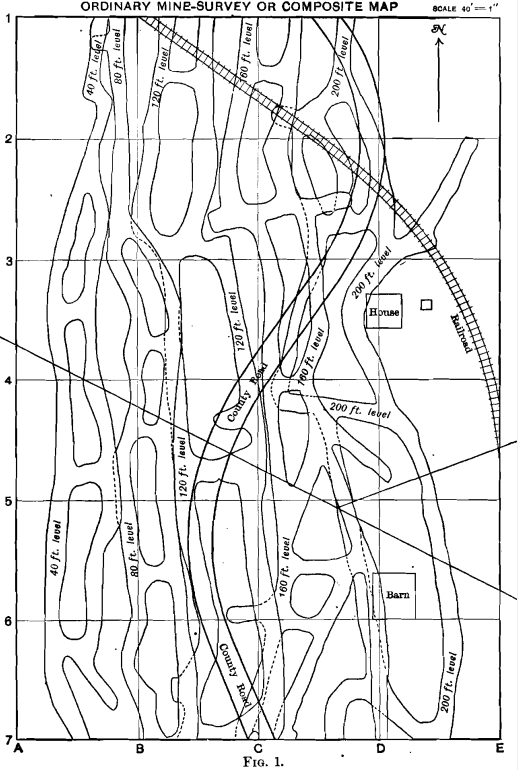
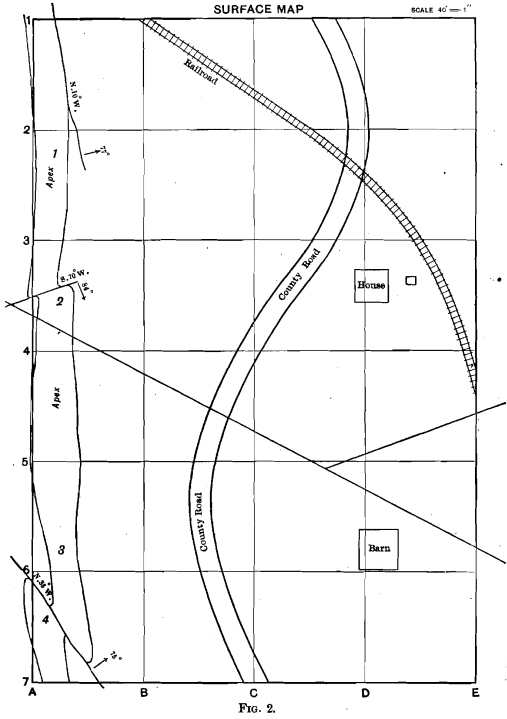
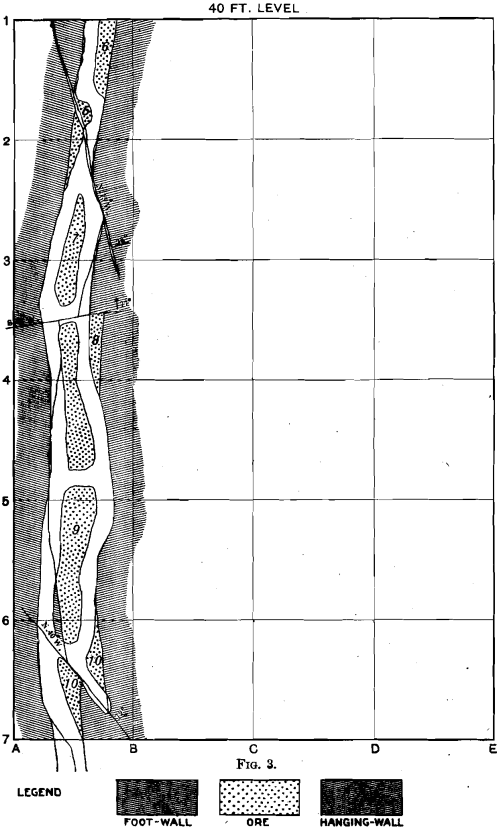
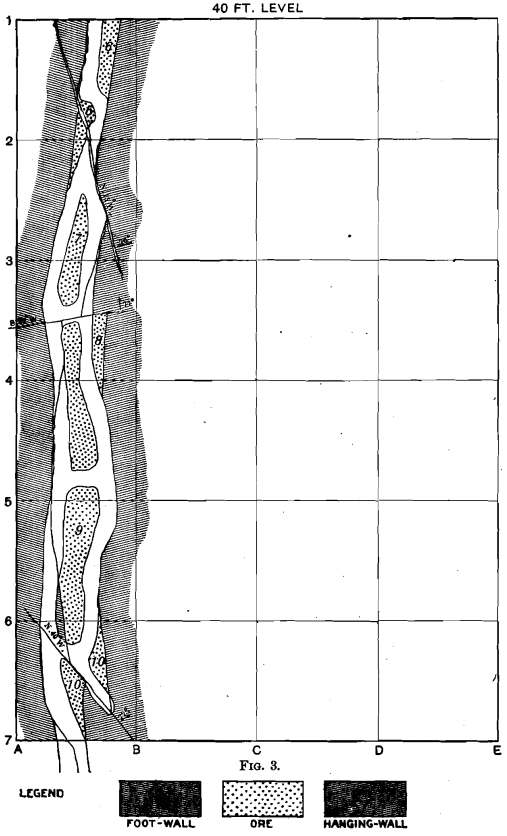
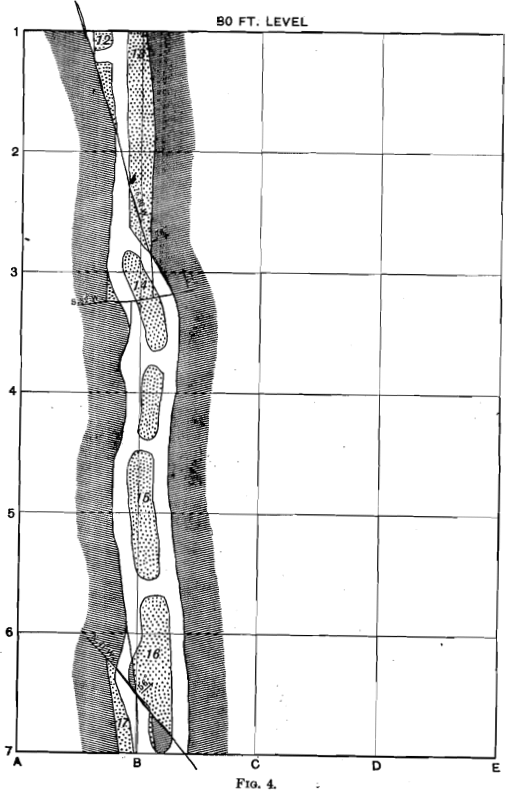
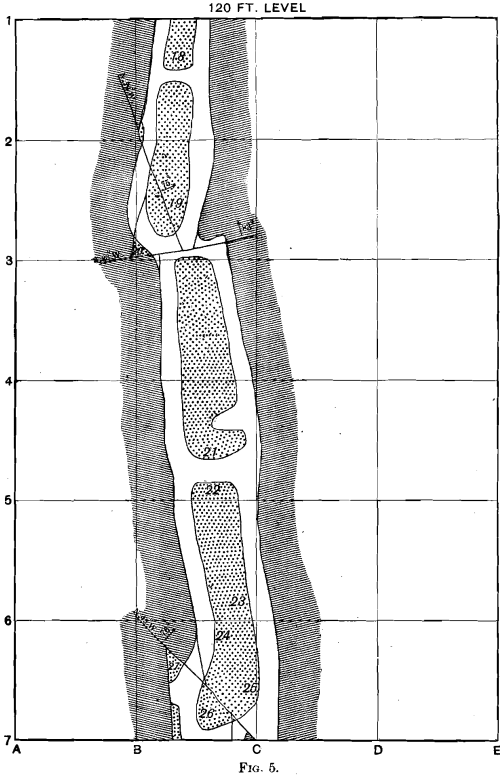
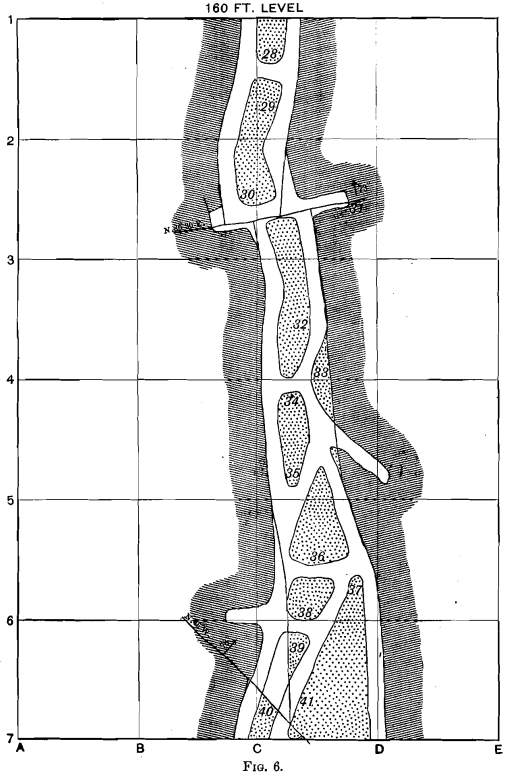
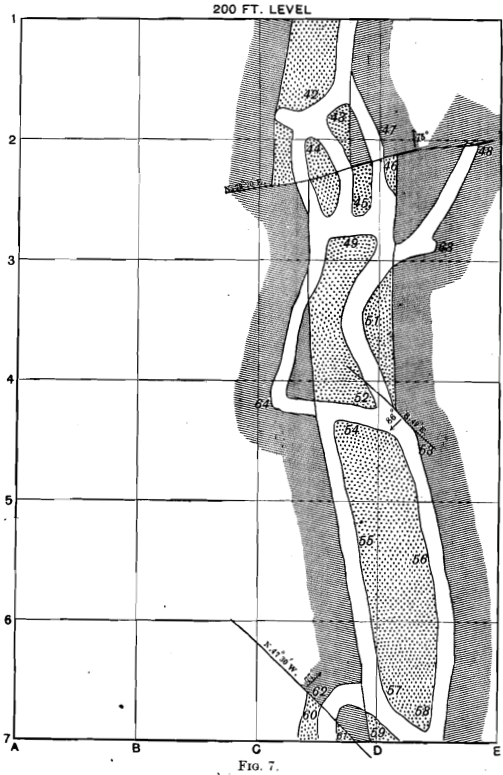
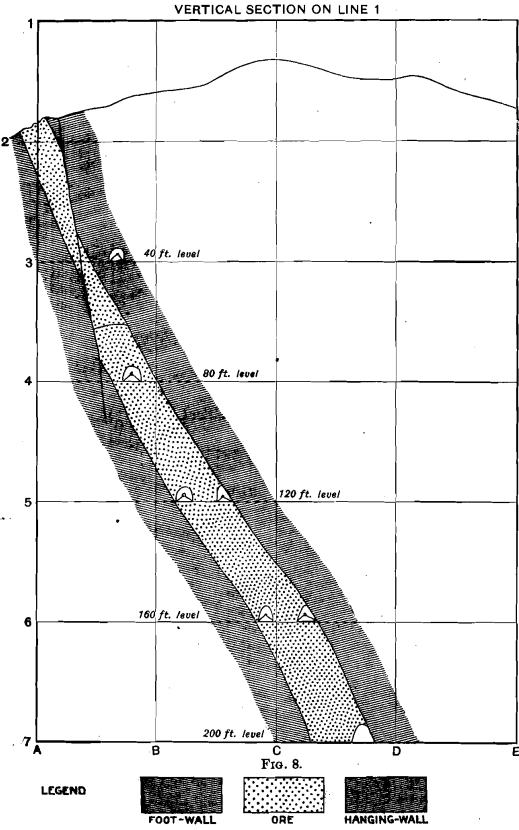
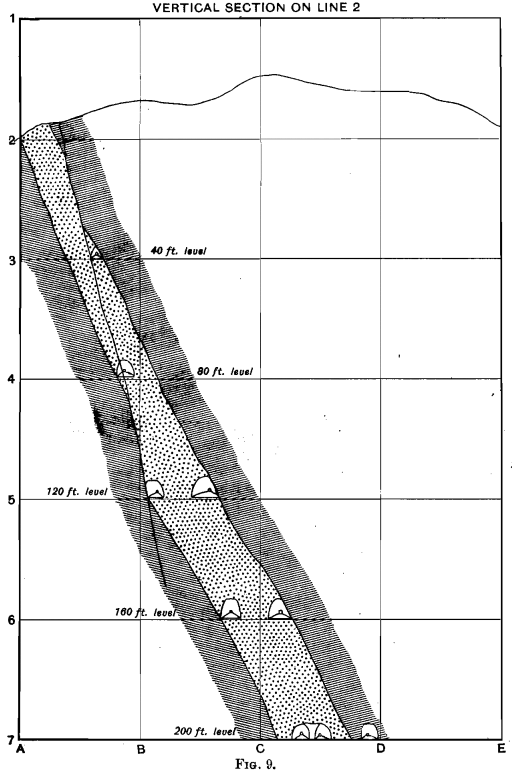
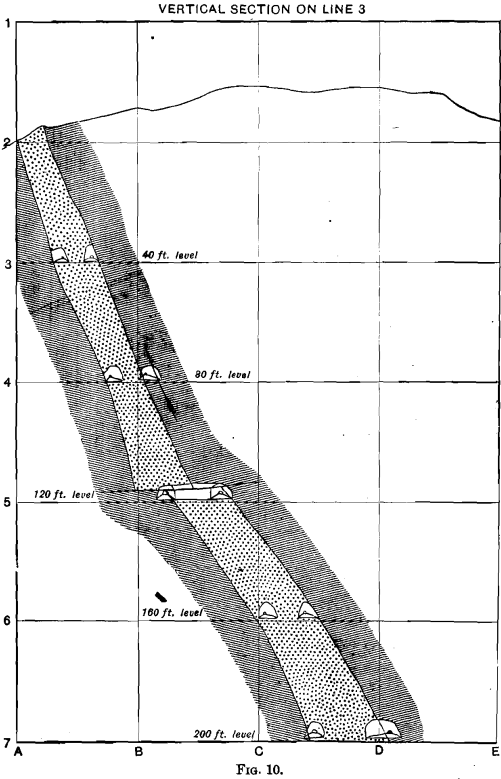
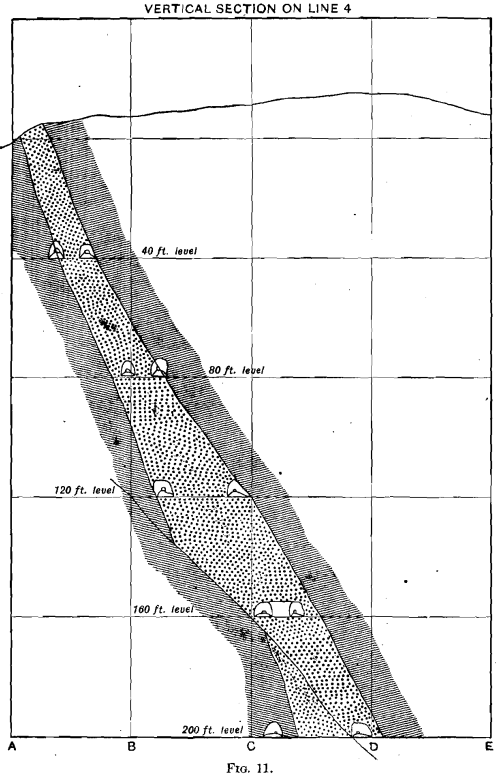
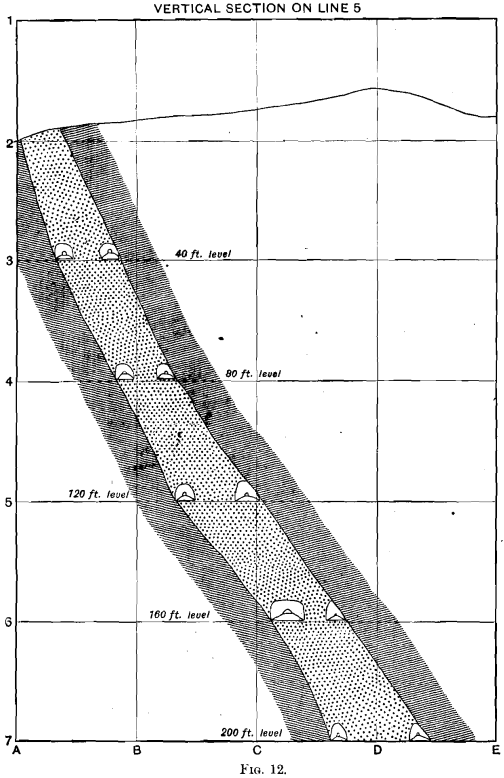
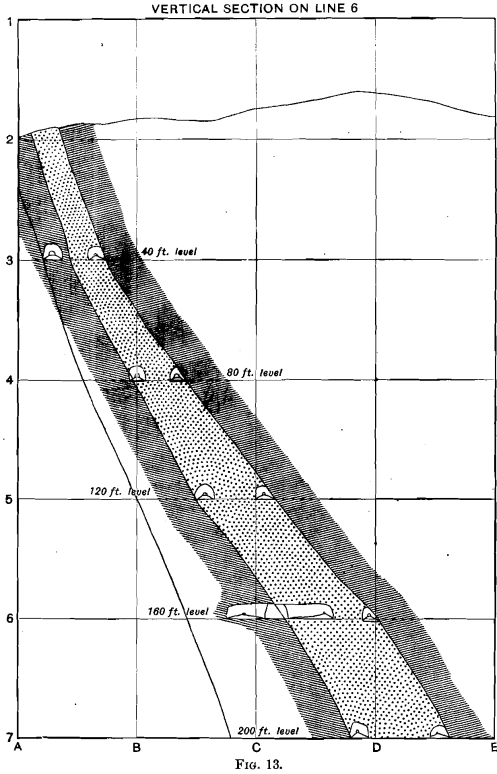
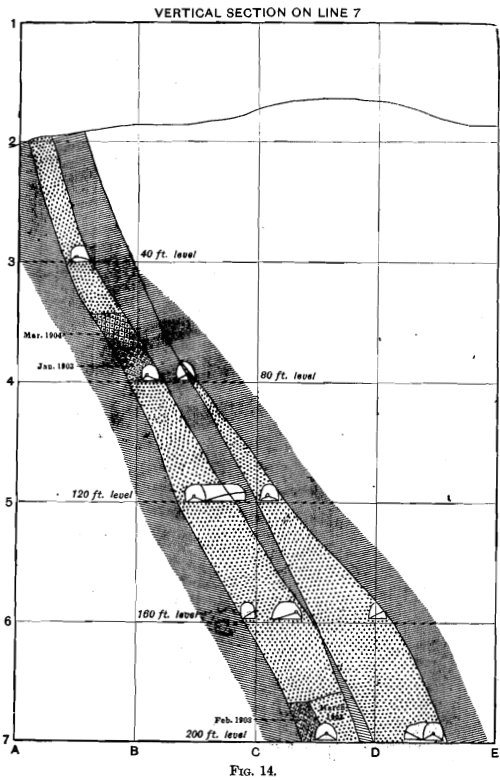
separate official, a competent mining-geologist, whose duty it should be to follow continuously all workings and surveys, and note with precision those indications which hard-worked superintendents, foremen and surveyors, however intelligent, might easily overlook or fail to record. The proper man for this most important work is a man who has nothing else to do, and who will do this one thing with industry, enthusiasm and technical knowledge.
Description and Discussion of Illustrative Drawings
These drawings represent an imaginary mine, presenting the ordinary conditions of practice.
Fig. 1 shows an ordinary mine-map, sometimes known as a composite map. This is useful only for showing the relations of the workings to each other and to the boundary-lines of the property. It does not form a record of the ore-bodies encountered, or the disturbances to which they may have been subjected, nor has it any great value as a guide in further developments.
In practice, this map would be tinted with a different color for each level. In the engraving, these colors are omitted, since the different tints, as well as the county-road on the surface, can be easily distinguished without such aid. It is evident upon an inspection of the map, that, since the levels at successively increasing depths (40 ft. vertically apart) are situated correspondingly further to the east, while they have a general north-and-south direction, the ore-deposit strikes N—S., and dips E. But this is all that the map can tell us concerning it.
Figs. 2, 3, 4, 5, 6 and 7 are the individual level-sheet geological maps. Each of these level-sheets is traced directly from the ordinary survey-map, after which the geology, as exposed in the openings and determined by careful examination, is platted on the map, care being taken to note the strike and dip of all faults, spurs and intersecting veins. Tracing-cloth is always used for these maps, both for speed and convenience in tracing from the working survey-map, and for the further reason that, when the level-sheets are in the holder, at least three sets of levels can always be seen through the translucent cloth, thereby affording an opportunity to determine the dip and trend of the ore-shoots, and consequently to project new workings with much greater ease than if observations were limited to a single sheet.
Fig. 2 (the surface-map) shows the outcrop of the ore-body a little further west than the line of the 40-ft. level in Figs. 1 and 3.
Figs. 8, 9, 10, 11, 12, 13 and 14 are vertical sections showing workings and geology. These sections, taken directly from the horizontal level-sheets, afford a very convenient means of studying the vein-structure, and at the same time of keeping a record of the ground stoped during each calendar month.
In addition to these advantages, the vertical sections afford an almost perfect check on the geology, which is nearly always noted first on the horizontal levels. Any errors, either in observation or interpretation, that may have crept into the geologist’s work, are sure to be detected when the vertical sections are platted.
